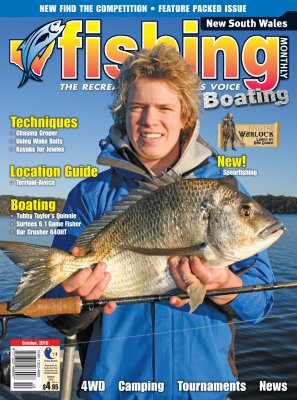The big blue truck by Andrew Badullovich
 The car heater growled as fingers hovered close to all outlets. It's Spring now, but the Winter chill lurks in the morning. Dribbling noses, cold cheeks, thank god for the hot fishing or you wouldn't get out of bed!
The car heater growled as fingers hovered close to all outlets. It's Spring now, but the Winter chill lurks in the morning. Dribbling noses, cold cheeks, thank god for the hot fishing or you wouldn't get out of bed!
Arriving at our first battleground, I unglove a hand damaged from the crab-gathering session the day before. The sting of crab juice on the open wounds is a minor irritation compared with the frostbite now setting in.
The crab bait flutters to the seabed, where it washes across boulders dotted with chitons, limpets and kelp. My line slackens and comes taut with the rhythm of the boat rising and falling on the swell and backwash.
Schooling sweep and yellowtail darting around the berley bucket distract me as my rod tip takes a sudden jerk toward the ocean. The unmistakable tap-tap-CRUNCH goes right through to my thawing bones as my rod arcs into the icy sea.
Even with near lock-up drag and two thumbs on the spool, line continues to run from the reel as the blue beast below hits another cog and puts more hurt on the reel's gearing.
My thumbs sizzle as the powerful run comes to a sudden halt as my opponent finds a frond of kelp but I manage to snig my prize clear and begin to muscle him back to the boat.
It seems the beast has spent its energy but I know my advantage is temporary. True to type, when he sees the boat he plunges hard towards the bottom but I hold tight and break his will. Spiralling up comes a blue brilliance; it threshes as it fills the Environet.
Cradling this beautiful fish, I struggle to maintain a smile for a photo before I slide the big boy back into the briny and watch him glide gracefully over a cunje-encrusted pinnacle.
MIGHTY BLUES
Reasonably common on coastal reefs, the EBG (eastern blue groper) has become an iconic species in NSW and is now the State fish emblem.
Best recognised by their prominent lips and brilliant blue flanks, displayed by male specimens only, these fish are sheer muscle when attached to a fishing line.
They are the second-largest of the wrasse family (Labridae), with their kissing cousins the western blue groper the largest.
EBGs can grow to 1m, with the heaviest recorded weighing 16kg. Most blueys average around 8kg. Although not huge fish, they make up for it with low-down and dirty pulling power!
EBGs were a heavy target for spearfishers during the 1960s and '70s, their docile and inquisitive nature making them easy targets. Their handsome appearance and exceptional eating qualities rocketed them to the top of the spearfishers' hit list.
Declining numbers led to a total capture ban for around 15 years and today anglers can keep a limit of two. It remains illegal to spear them.
There's a minimum legal length of 30cm with only one of your two permitted fish allowed to measure 60cm or more.
The 'big blue' is the dominant male and the squadron of smaller brown or red groper are females. The female reaches sexual maturity between 24cm and 34cm, while the sex change into a blue male can occur around 60cm.
One blue will dominate his particular domain, generally a pebbly gutter or hole close to a wash zone, gathering a harem of around 10 females. If this male dies, is captured or simply moves on, the largest brown transforms into a male and turns blue.
The majority of browns weigh 2kg to 3kg, with the dominant blue 6kg to 10kg. However, if those browns range from 4kg to 7 kg, then you're in for a real treat when Mr Big Blue Truck decides to jump on the end of your line!
BAIT UP!
Crabs, cunjevoi, prawns and squid are great groper bait. Crabs and cunje can be collected on most rocky foreshores at low tide. Gather crabs by hand and cut cunje with a knife to access the purple flesh inside.
Crabs and cunje are my preferred baits, but check marine park charts to ensure you're not collecting from a no-take zone.